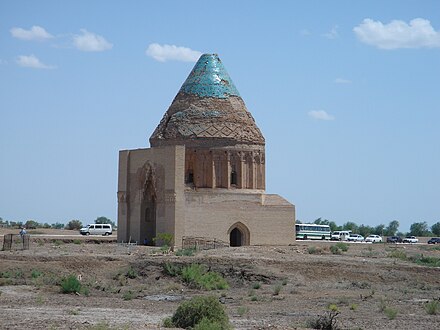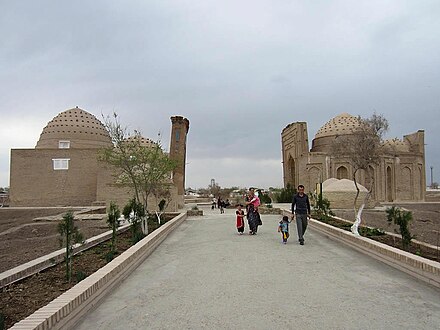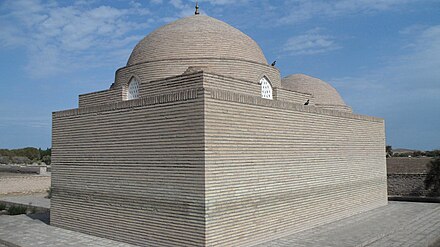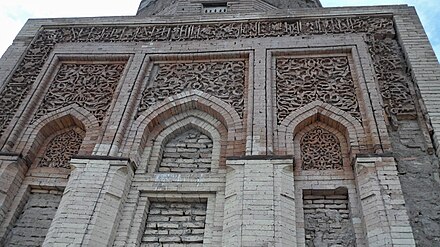Konye Urgench - city
Konye Urgench is a city in Dashoguz Province, Turkmenistan.
Understand

Konye Urgench was built on the crossing of two major caravan routes from the south to the Volga in the northwest and from the west to China in the east. From the 1st century AD onwards Konye Urgench was an important trade centre on the Northern branch of the Silk Road leading to the Caspian Sea and Russia. Around 1000 Emir Mamun unified the country of Khwarezm and made Konye Urgench its capital. In the 10th century, Urgench was the capital of the powerful Khwarezm state which occupied the whole area of the Amu Darya delta in Northern Turkmenistan and Western Uzbekistan.
Konye Urgench became one of the centres of the Islamic world and was called "the heart of Islam" and "the capital of thousand wise men". Great scholars as Al Biruni (Abu Reikhan Biruni) and Avicenna (Abu Ali Ibn Sina) lived here. After its conquest by the Mongols in the 13th century, the city became an important trade centre again. The Arabic traveller of the 1300s, Ibn Batuta, described Konye Urgench as the 'biggest among the Turkish cities with broad streets and splendid bazaars'. The main part of the magnificent monuments in Konye Urgench were built during the reign of Kutlug Timur and his wife Tyurabek-khanym. In the 14th century the city was destroyed by the troops of Timur.
Konye Urgench was declared a UNESCO World Heritage Site in 2005.
Get in
By plane
Turkmenistan Airlines operates several daily flights from Ashgabat to Dashoguz.
By bus or taxi
There are frequent buses and marschrutki from Ashgabat (US$4, 10 to 12 hours) and from Dashogus (US$0.50, 2 hours). Taxis from Ashgabat cost about US$6 per seat or US$24 for the whole car, from Dashogus US$0.75 per seat or US$3.50 for the whole car. The bus station is outside town, near the Gürgenc Hotel. From there you will need a taxi to the town centre.
By car
Konye Urgench is about 100 km from Dashoguz and 480 km from Ashgabat.
Get around
There is no public transport in Konye Urgench. The sights of Konye Urgench are spread over the town. A taxi to the most distant monuments (Turabeg Khanym Mausoleum, Sultan Tekesh Mausoleum, Kyrk Molla and Il-Arslan Mausoleum) and back will cost about US$2 including waiting time.
See

- Nedjameddin Kubra Mausoleum was built in the 14th century. It is considered as the holiest place in Konye Urgench. Nedjameddin Kubra lived in the 12th/13th centuries. He was born in Khiva and became a famous religious teacher known as 'designer of saints'. He left several treatises on mystic experiences, founded an important Sufic order and was killed by the Mongols.
- Konye Urgench Museum in the modern Dash mosque (US$1, W-M 08:00-13:90, 14:00-16:00). Some rooms contain ethnographic exhibits including a pottery workshop and carpet looms.
The most interesting monuments are on both sides the Ashgabat road about 1 km south of the town. Admission is US$1, camera US$0.70, open from 08:00 to 18:00.
-
Turabeg Khanum Mausoleum is one of Central Asia's most beautiful buildings. It was built in the 14th century by Kutlug Timur for his wife Turabeg Khanum. Its portal with a height of 21 m and a breadth of 14 m is richly decorated with majolicas. The central building measuring about 100 m² is also ornamented with colourful tiles. The interior of the dome (height: 20 m) shows 365 stars symbolizing the days of the year, 12 open and 12 closed arches symbolize the hours of day and night, 12 bigger arches symbolize the 12 months and 4 big windows the four seasons.
-
Kutlug Timur Mínaret was begun in the 11th century and finished in the 14th century unter Kutlug Timur. It was the minaret of the main mosque in Konye Urgench. With a height of 60 m, it is the highest minaret in Central Asia. The minaret is divided by 18 belts with an ornament and 3 belts with Kufi inscriptions.
-
Sultan Tekish Mausoleum is the mausoleum of Sultan Tekish, shah of Khorezm in the 12th century, who conquered a huge territory from the Aral Sea the Persian Gulf and from what is today Iran to the Pamir. This mausoleum is one of the few monuments in Konye Urgench surviving from pre-Mongol times. The dome was richly decorated with blue tiles and geometrical patterns. The mausoleum was 30 m high and serves as a lighthouse in the desert and as a symbol of authority (as it stood high above ordinary houses).
-
Kerk Mollah (Hill of the 40 mullahs) is one of the best known places of pilgrimage in Turkmenistan.
-
Il-Arshan Mausoleum is Konye Urgench's oldest surviving monument. It contains the grave of Il Arslan, the father of Sultan Tekish. The dome in the form of a tent and the facade of the monument with a pattern of bricks are the first of this type and were the prototype for similar buildings in Samarkand.
-
Minaret of Mamum. The minaret of the 10th to 11th century collapsed about 100 years ago. The foundation slab was found indicating that the minaret was constructed by order of Shah Mamun.
.jpg/440px-Inner_Dome_of_Turabeg_Khanym_Mausoluem_(27574334687).jpg)
-
Ib-Khadzhib Madrasa. 14th to 16th century.
-
Mausoleum of Fakhr ad-Din Razi. 13th century.
-
Mausoleum of Azizan Al-Ramatani. 13th to 14th century.
-
Mausoleum of Seid Ahmed. 12th to 14th century.
-
Mausoleum of Piryarveli. 13th century.
-
Mausoleum of Gulidergan. 12th century.
-
Mauseoleum of Khorezimbag. 13th to 18th century.
-
Mausoleum of Dashgala. 14th to 16th century.
-
Mausoleum of Matkarim Ishan. 19th to 20th century.
-
Mausoleum of Sultan Ali. 16th century.
-
Mausoleum of Dashmedzhet. 20th century.
-
Ak Kala Fortress. 1st to 13th century.
-
Izmukshir. The ancient city of Zamakshar with magnificent fortress ruins was the birthplace of the great 10th century philosopher Az-Zamakshari.
-
Dashmechet Madrasah. The Madrasah was erected in the beginning of the 20th century. It is a one-storey brick building with a high portal, 4 towers and 19 living rooms for the students.
Do

Buy
Eat
- Bedev Cafe, Azadi köcesi, +993 347 21044. 07:00 to 21:00. US$3
Drink
Sleep
- Gürgench Hotel, Dashogus Köcesi (out of town). No running water, pit toilets outside. US$6
- Chapayev Guesthouse. Only recommended if you have your own transport. US$2.50
There is no comfortable hotel in Konye Urgench. It is better to stay overnight at Dashoguz.
Connect

Go next
By plane
Turkmenistan Airlines operates several daily flights from Dashoguz to Ashgabat.
By bus or taxi
The bus station is outside town, near the Gürgenc Hotel. You will need a taxi from the town centre to the bus station.
There are frequent buses and marschrutki to Ashgabat (US$4, 10 to 12 hours) and to Dashoguz (US$0.50, 2 hours). Taxis to Ashgabat cost about US$6 per seat or US$24 for the whole car, to Dashoguz US$0.75 per seat or US$3.50 for the whole car.
Konye-Urgench
Date Time:Please wait...Timezone:Asia/AshgabatPopulation:34,677Coordinates:42.32, 59.16
Daşoguz Region
Primary administrative division